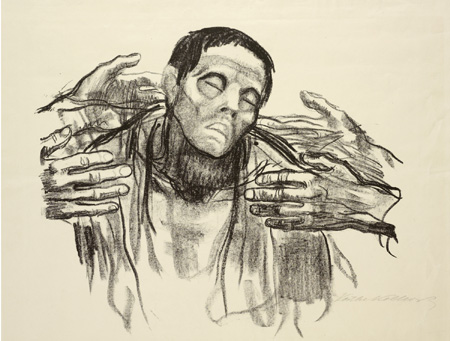- 1867-1945
- Regarded as one of the most important German artists of the 20th century.
- Born 1867 in Konisburg, East Prussia.
- She studied art in Berlin and began making etchings in 1880.
- 1898-1903 taught at the Berlin School of Woman Artists.
- 1910 began to produce sculpture.
- 1914 son Peter was killed in Flanders, his death contributed to her socialist and pacifist political ideals.
- The artist believed art should reflect the time it is made in, her works reflected her concern with war, poverty, women and the lives of the working class.
- She became the first woman elected to the Prussian Academy of Arts, however she was expelled from the academy when Hitler came to power.

The Parents (1932) - Kathe Kollwitz
- In 1932 the war memorial to her son Peter was dedicated at Vladslo Military Cemetery. The piece was entitled "The Parents".
- The idea of this memorial was formed in 1914 with the initial composition of the son's body outstretched, father at the head and mother at the feet. However in 1919 the project was temporarily put aside.
- It was 12 years later that the piece was at last erected. The work was exhibited at the National Galery in Berlin. It was then moved to Belgium where it was placed adjacent to her son's grave.
- The work is a reminder that war does not end on the day it is declared over; for the ordinary person it carried on long beyond that date.
- The grief of a parent and loss became central themes of Kollwitz work, depicting the turmoil and consequences of war.
- The parents in the sculpture are depicted kneeling, mother is bent forward in her grief, head down, hiding her expression. The father stares ahead, forcing the viewer to confront his pain.
There is no artist's signature, no location in time or space - only the universal sadness of two aged people, surrounded by the dead like 'a flock of lost children'. The phrase is Kathe Kollwitz's own.
- Her work also focuses on guilt and responsibility, particularly of older generations to the younger. Particularly in the case of the young people killed at war Kollwitz felt that the young people had been betrayed.
- Her work often references the grief of the Virgin Mary, drawing inspiration from the Pieta and its composition.

Self Portrait (1923) woodcut - Kathe Kollwitz

Help Russia! (1921) transfer lithograph - Kathe Kollwitz

life-sized copy of Kathe Kollwitz' sculpture, in memory of those who died in World War Two.



.jpg)
